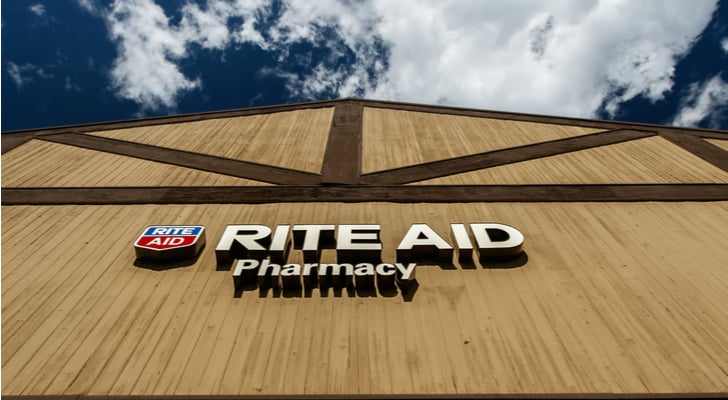With the echoes of the mostly-disappointing deal with Walgreens Boots Alliance Inc (NASDAQ:WBA) still ringing, it would have been easy to forget Rite Aid Corporation (NYSE:RAD) was slated to release its fiscal third quarter numbers after Wednesday’s close. Owners of RAD stock, however, got a painful reminder that there’s more to the story than Walgreens.
How painful? RAD stock was down roughly 6% in Wednesday’s after-hours action and Thursday’s early trading, as investors weighed the earnings beat against the revenue miss, and decided the glass was half empty rather than half full.
And yet, given what the results confirm, who can blame them?
RAD Stock Recap
For the quarter ending in early December, drugstore chain Rite Aid turned $5.4 billion worth of revenue into an operating loss of $18.2 million, or effectively a breakeven on a per-share basis. That compares to a profit of three cents per share of RAD stock for the comparable quarter a year earlier, when it reported sales of $5.7 billion.
Analysts were expecting a top line of $7.74 billion and a loss of two cents per share of RAD stock. On a non-GAAP basis, Rite Aid earned $81 million, or eight cents per share, thanks to one-time tax matters and fee income.
More alarming is that same-store sales fell 2.5%, with lagging pharmacy sales responsible for the bulk of the decline.
CEO John Standley commented on the fiscal third-quarter-earnings results:
“I would like to thank our entire Rite Aid team for their dedication and efforts in accomplishing this important business initiative for our company and our shareholders. To date, we have transferred 357 stores and have received approximately $715 million in proceeds, which we have used to pay down debt. Looking forward, in addition to completing the transfer process, we will continue to focus on our most significant business-building opportunities as we work together to deliver a great experience to our customers and patients.”
Standley better start delivering more of those great experiences, and soon.
Backpedaling on RAD Stock
To a certain extent, it’s arguable the company’s top brass were too distracted by the deal-making with Walgreens to rev the organization’s revenue engine. That’s a weak argument though.
Rather, last quarter’s results extend what’s become a long streak of deteriorating results that indicate it’s just failing as a retailer. Walgreens’ cash in exchange for Rite Aid stores may help pay down debt (and that is the plan) but less debt doesn’t shore up the company’s inability to operate a successful, reasonably-profitable retailing operation.
As evidence of the bigger struggle, spending on selling and administrative expenses barely budged despite shrinking revenue. And, as a percent of revenue, the Rite Aid SG&A spending actually grew from 24.5% to 25.2%, year-over-year.
EBITDA from Rite Aid’s continuing operations, which excludes the interest payments stemming from the company’s debt load, fell from $139 million in Q3 of last year to $89 million this time around. As a percent of sales, EBITDA slumped from 3.4% to 2.2%, year-over-year.
In its defense, some of the headwinds RAD stock faces are beyond its control. It opted to participate in fewer Medicare Part D programs due to profitability concerns, and falling reimbursement rates have made things tough. Rivals CVS Health Corp (NYSE:CVS) and Walgreens, however, have managed to handle the same headwind just fine.
Looking Ahead for RAD Stock
Rite Aid doesn’t offer guidance, but prior to the release of the third-quarter report, analysts were calling for sales of $6.9 billion and a loss of one cent per share for the quarter currently underway. That revenue outlook is almost 20% weaker than the year-ago level, when the company broke even.
Some of the projected setback stems from the fact that Rite Aid has already begun the transfer of 1932 stores to Walgreens Boots Alliance; Rite Aid handed the buyer the keys to 97 units last quarter, and has to-date transferred 357 stores. More are being officially passed along every day, scaling back the company’s capacity to drive revenue.
Regardless, it’s clear that Rite Aid is still struggling, and mostly unable to do a thing about it. Same-store sales are sinking, as is net income, suggesting the waning scale has hurt more than helped so far. It’s tough to imagine margins meaningfully improving in the future, less debt or not.
As of this writing, James Brumley did not hold a position in any of the aforementioned securities. You can follow him on Twitter, at @jbrumley.

